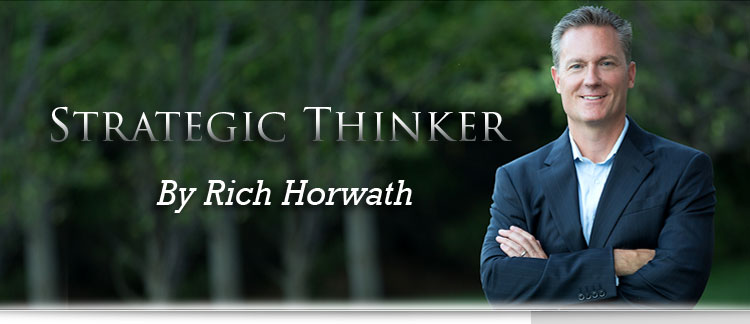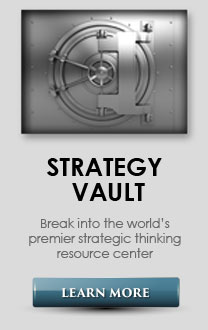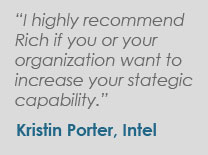
Simplify"Simple can be harder than complex: You have to work hard to get your thinking clean to make it simple. But it's worth it in the end because once you get there, you can move mountains." Steve Jobs, Co-founder, Apple To simplify a business, one must first think and plan. However, for many people, the idea of simplifying through planning is the exact opposite of what they've experienced. Often times, planning has come to mean greater complexity in the form of rambling meetings, data-dump spreadsheets, and mountains of templates. The complexities created by poor or non-existent planning foster a culture of reactivity, where life becomes a never-ending series of fire drills and firefighting. Oddly enough, these time-wasting activities are considered by many to be real work. Perhaps that's because we live in an action-oriented world. Better to be doing something, anything, then to be seen as not "in action." And if by anything we mean activities such as fighting fires, reacting to competitors, checking our smartphone every 6 ½-minutes (average according to research), or perusing social media, the activity-oriented approach doesn't necessarily equal achievement. When it comes to the great contributors throughout history, dating back to people like Leonardo da Vinci, Thomas Jefferson, Albert Einstein, Ernest Hemingway, up through business luminaries such as Bill Gates, Steve Jobs and Jeff Bezos, a common theme is their ability to take time to think and plan. It's one of the traits that set them apart. The ability to think and plan is not common. According to a study of 547 managers, when skills required were compared with skills possessed, the #1 area of leadership skill deficiency was strategic planning. Circuit City was identified through rigorous research by Jim Collins in his book Good to Great as one of the top 11 companies in the world back in 2001. Eight years later, Circuit City declared bankruptcy. In his cleverly titled book, Good to Great to Gone, former Circuit City CEO Alan Wurtzel, who orchestrated the company's rise to top 11 in the world, described how the company eventually lost its' way after his departure. "By undervaluing, and then discontinuing, long-range strategic planning, [the CEO] was, in effect, driving down a dark road without headlights. He faced many serious challenges that needed to be attacked decisively and in a coordinated manner, but without a strategic plan he was doomed to fail." The importance of planning can be found in both empirical and anecdotal evidence. Research published in the journal Strategy & Leadership on more than 100 companies showed that 70 percent of successful businesses started from a process of strategic planning. Alan Mulally's Lazarus-type resurrection of the Ford Motor Company from a $12.7 billion-dollar loss in 2006 to a net income of $20.2 billion in 2011 was due in large part to his discipline to plan. Mulally instituted a weekly leadership meeting called the "Business Plan Review" (BPR). The management team initially resisted the BPR, citing that they were too busy for these types of meetings. The individuals believed that they need only focus on their part of the business and that this planning was wasting their time. What's most amusing about their attitude is that this is the same group that was getting smoked by their foreign competitors at the time. But Mulally remained committed to thinking and planning. He said, "I know how successful it can be when a business has a plan, everybody knows the plan and everybody knows how we are performing against that plan." One organization I encountered had a three-year period where their sales hovered around $400 million. I facilitated a strategic thinking and planning process designed to fit their business and instill in the group a renewed sense of focus and discipline. Once their entire leadership team engaged in a process of strategy conversations, strategic thinking and planning, they jump-started their business growth over the next five years and increased annual revenue to nearly $1 billion. The thinking and planning process helped them to cut out static market segments, divest unprofitable product lines and design a one-page visual summary of their organization's future strategy. Make no mistake, it was the leadership team's deep business expertise which fueled this growth, because it was now channeled and focused on applying their core competencies and capabilities to untapped growth opportunities. Just as important, their clarity of thinking enabled them to more effectively lead strategy conversations with their functional teams. It also prepared these managers to communicate strategies cross-functionally and take accountability for generating new insights to the business. To simplify through thinking and planning, focus on the following three areas: 1. People. We know through experience that people at any level of an organization can make important contributions to the profitable growth of the business. The title designation on the business card isn't always an indicator of the power of someone's insights. There are two types of people that can make things unnecessarily complex. The first type is what I refer to as the "Sinatra Strategist"—a spin on Frank Sinatra's song "My Way" where this manager doesn't allow anyone else to contribute input in the development of the strategy. In some instances, they mistakenly believe they are easing the burden on everyone else by handling the strategy development themselves. In other cases, they believe that they and only they are capable of developing strategies. Either way, the organization loses out in the long term because it creates a myopic view of the future and leads to the under-development of other top-level managers. The most powerful strategic thinking and planning is done by both individuals and groups. While the Sinatra Strategist may have success in special circumstances such as markets with little competition or that are highly regulated, sooner or later "My Way" will depend just as much on "Luck be a Lady." The second type is what I refer to as the "IDIOT." Now, by IDIOT, I'm not referring to the "notably stupid"—that would, by definition, be a moron. I'm sure you don't have any of those where you work. I'm using IDIOT as an acronym for "Individuals Doing Irrelevant Obsolete Tactics." Do you have anyone that fits that description? When managers don't have a plan to work from, they typically fall back on a laundry list of things to do. While checking stuff off this list may be satisfying, it conceals exactly how out of touch a manager can be with their business. If a manager is not methodically thinking through the changes in market trends, customer value drivers, competitive landscape and company patterns on a regular basis, how can they be sure the tactics they're using are creating differentiated value for their customers? Answer: they can't. So instead of developing innovative initiatives that continually evolve into a system of strategic advantage, they churn out the same old tactics year-after-year. Sound familiar? It's difficult to simplify if either one of these two types of people are figuring prominently in your business. To prevent them from derailing your success, schedule both individual and group strategy conversations on a regular basis using a framework and tools. 2. Process. Similar to Goldilocks' dilemma of finding a bowl of porridge that was just right, process can be either too much or not enough. On the too much side, I've seen some organizations conduct their brand planning processes for 4-6 months each year, with multi-day presentations as a grand finale. The challenge with too much process is that it constantly occupies managers' minds, weighing down their morale with the struggle of too many needless meetings, too many internal reviews and too much of the same, regurgitated information from the previous year. It also restricts creativity and energy needed for the communication and execution of strategies. A rule of thumb I use with groups where I'm facilitating strategic planning is if we can't tie an exercise, template, or slide to a key insight, it's gone. As Tesla co-founder and SpaceX CEO Elon Musk said, "The problem is that at a lot of big companies, process becomes a substitute for thinking." On the flip side, some organizations add needless complexity to their day-to-day operations because they have too little process. For some, the lack of process is due to the fact that they relied solely on a novel product as they started up, which is most noticeably seen in technology and biotechnology sectors. However, once they begin to significantly scale, the lack of process manifests itself in the organization's inability to make trade-offs across functional groups and their failure to focus resources in the areas that offer the highest potential for profitable growth. I've also observed senior leaders, especially those new to the organization, not wanting to impose "their process" on the group. While this may avoid internal conflicts early on, it makes the leader's job exponentially more difficult in the long run. Instead of having a simple process that the leader is confident will help her team comprehensively think through the business, she has no assurance at all that her managers are seeing the big picture. It also requires her to start from scratch with each leader to hunt and peck for answers that will indicate this manager has explored the range of business models and strategies that give them the greatest chance of success. When it comes to process, use one that is simple and concise. My research with more than 75 organizations has shown that there are five steps when it comes to best practices for a strategy process: 1. Discovery; 2. Strategic Thinking; 3. Strategic Planning; 4. Strategy Rollout; 5. Strategy Tune-up. Include some version of these five steps and you're well on your way to an effective, yet concise, process to simplify your business. 3. Plan. I've seen marketing plans that include lots of data-filled graphs and no insights. I've seen account plans that have up to ten tabs in the Excel document, making navigation almost as daunting as updating the thing. And I've seen strategic sales plans that run more than 100 slides but didn't include the word "strategy" anywhere in the PowerPoint deck. Plans like these are not going to simplify your work, they are only going to obscure it. There are two fundamental elements to any plan: 1) What are you trying to achieve? 2) How will you achieve it? That's it. Sure, there are other elements we can include such as purpose (mission, vision, values), business model factors (core competencies, value proposition, etc.) and market/customer/competitive intelligence. But, answer those two questions clearly and concisely and you've built a solid foundation. As you develop your plan, there are two criteria that will distinguish the transformational plans from the doorstops: Size: If you can distill the essence of the business into 1-2 pages/slides, it has the potential to be updated on a regular basis and actually used throughout the year to drive daily activities. I recommend using a StrategyPrint®, or two-page blueprint, that includes both insights and action plan. Impact: If the plan is nothing more than a laundry list of to-do's, it's not really a plan. A plan that only includes the elements that will make or break the business has the potential to be a game-changer. As a business grows, it tends to become more complex. Like a tree that's never been pruned, this complexity can choke off good opportunities and siphon off resources to needlessly feed dying branches of the business. Replacing action with thoughtful action in the form of thinking and planning is one way to simplify. As William Shakespeare wrote: "So may a thousand actions, once afoot |








